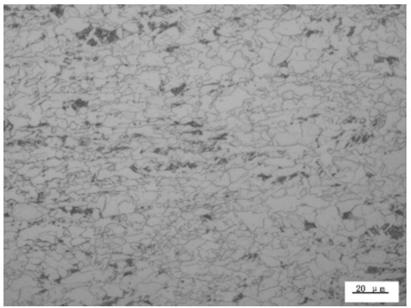Low-yield-ratio Q370qNH steel plate and preparation method thereof
A low yield ratio, steel plate technology, applied in the field of iron and steel metallurgy, can solve problems such as easy cracking, and achieve the effects of reducing surface cracks, improving strength, and inhibiting grain growth
- Summary
- Abstract
- Description
- Claims
- Application Information
AI Technical Summary
Problems solved by technology
Method used
Image
Examples
specific Embodiment approach
[0024] The purpose of the present invention is to provide a weather-resistant bridge steel plate with a yield strength greater than 370 MPa, low yield ratio, good corrosion resistance, low temperature toughness, cold forming performance and welding performance, which can be used without coating. The following specific implementation methods will be adopted accomplish:
[0025] In the first embodiment of the present invention, the present invention provides a low yield ratio Q370qNH steel plate, the components of the steel plate are: C: 0.04-0.06%, Si: 0.20-0.30%, Mn: 1.2-1.4%, P: ≤0.015%, S: ≤0.008%, Nb: 0.01-0.02%, Cu: 0.25-0.35%, Ni: 0.3-0.4%, Cr: 0.4-0.5%, Als: 0.024-0.034 %, the balance is Fe and unavoidable impurities.
[0026] According to a preferred embodiment of the present invention, the composition of the above-mentioned steel plate is: C: 0.04-0.06%, Si: 0.21-0.23%, Mn: 1.21-1.25%, P: ≤0.011%, S: ≤ 0.003%, Nb: 0.012-0.015%, Cu: 0.29-0.31%, Ni: 0.32-0.35%, Cr: 0.4...
Embodiment 1
[0035] Smelt according to the chemical composition shown in Table 1, and cast into steel ingots, heat the steel ingots to 1210 ° C, and the total time in the furnace is 252 minutes, and carry out the first stage of rolling on the experimental rolling mill, that is, rolling in the austenite recrystallization zone. The rolling start temperature is 1176°C, the reduction in the first to second passes should be greater than 10%, and the reduction rate in at least 1 to 2 passes should be controlled above 25%. Temperature to 930 ° C, followed by the second stage of rolling, that is, rolling in the austenite non-recrystallized zone. The final rolling temperature is 830°C, and the thickness of the finished steel plate is 14mm. After rolling, the steel plate enters the laminar flow cooling device and is cooled to 630°C at a rate of 10°C / s, and finally the steel plate can be obtained.
Embodiment 2
[0037] The method is the same as in Example 1, wherein the heating temperature is 1220° C., and the total time in the furnace is 256 minutes. The rolling start temperature of the first stage rolling is 1175° C., and the thickness of the intermediate billet is 60 mm. The rolling start temperature of the second stage rolling is 925°C, the final rolling temperature is 836°C, and the thickness of the finished steel plate is 20mm. After rolling, the steel plate enters the laminar flow cooling device and is cooled to 620°C at a rate of 12°C / s, and finally the steel plate can be obtained. Such as figure 1 As shown, the metallographic structure of the steel plate obtained in this embodiment is shown, and it can be clearly seen from the figure that the metallographic structure of the steel plate obtained by the present invention is mainly ferrite and pearlite, and the grains are dense and refined , so that the steel plate prepared by the present invention has strong strength and low t...
PUM
| Property | Measurement | Unit |
|---|---|---|
| yield strength | aaaaa | aaaaa |
| tensile strength | aaaaa | aaaaa |
| thickness | aaaaa | aaaaa |
Abstract
Description
Claims
Application Information
 Login to View More
Login to View More - R&D
- Intellectual Property
- Life Sciences
- Materials
- Tech Scout
- Unparalleled Data Quality
- Higher Quality Content
- 60% Fewer Hallucinations
Browse by: Latest US Patents, China's latest patents, Technical Efficacy Thesaurus, Application Domain, Technology Topic, Popular Technical Reports.
© 2025 PatSnap. All rights reserved.Legal|Privacy policy|Modern Slavery Act Transparency Statement|Sitemap|About US| Contact US: help@patsnap.com



